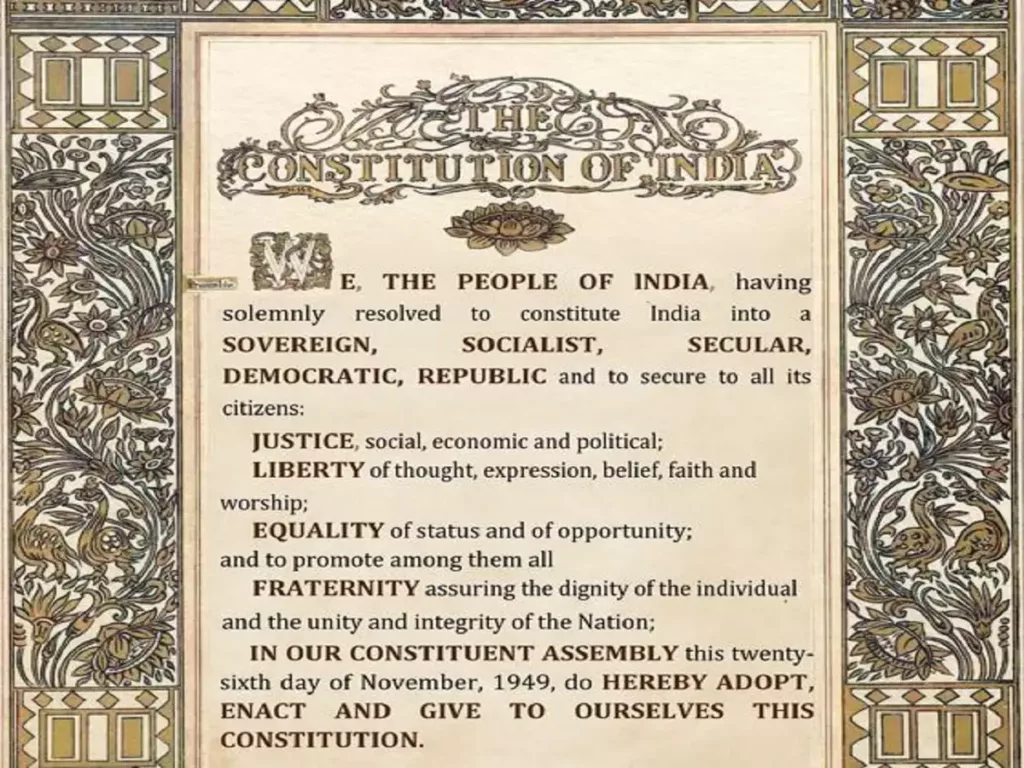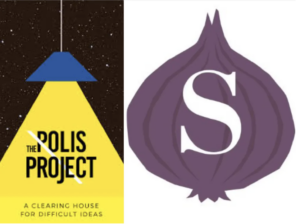


In the last few weeks of 2019, the Preamble to the Indian Constitution acquired an unprecedented significance in the history of modern India, 70 years after it was adopted. With the passing of the Citizenship (Amendment) Act, 2019 (CAA) in both the houses of Parliament in December 2019, spontaneous outbursts of protests occurred across India. These protests continued incessantly mostly fueled by the youth, women and supported by intellectuals, professionals and even some political parties and actors.
One of the significant features of these protests has been the invoking of the Preamble of the Constitution at public rallies, in university campuses and even in front of the Supreme Court. The Preamble is being invoked in the digital sphere as well, with the document being used in profile pictures, posts or recited on various social media platforms. Reciting the Preamble in the public sphere – both in the physical and the digital space – as a form of assertion of rights and liberties granted through the Constitution is one way in which it steps out from the conceptual domain into the world of social movements. It is now a more active document even though it has always been an integral part of the lives of the Indian public through its assertion, interpretation and invocation in the legal sphere, through court judgments and the formulation of laws, policies and acts as well as their implementation.
This article takes a look at some of the most prominent judgments of the Supreme Court of India which have referred to, analyzed or invoked the Preamble. In what follows, I will trace the evolution of its legal, constitutional and political standing while exploring how some of the basic features of the Preamble have been interpreted by the Supreme Court in its judgments. The aim is to highlight the legal and practical importance of the Preamble for the common public especially when it has become such an important symbol for the present protest movements.
The Berubari Union vs. Unknown, 1960
As one of the key cases in which the legal standing of the Preamble was evaluated, the judgment in the Berubari Union case was important as it not only addressed the principle of sovereignty, but also the competence of the Parliament in legislating on issues that impact key features of the Indian Constitution as enumerated in the Preamble. In doing so, the powers of the Preamble were examined in being used for imposing restrictions on the legislature in dispensing its legislative functions. The judgment remarked that:
“There is no doubt that the declaration made by the people of India in exercise of their sovereign will in the Preamble to the Constitution is, in the words of [Joseph] Story, “a key to open the mind of the makers” which may show the general purposes for which they made the several provisions in the Constitution; but nevertheless the Preamble is not a part of the Constitution” (Supreme Court, 1960: 12).
The judgement rejected the argument that the Preamble imposes any limitation or restriction on the “exercise of what is generally regarded as a necessary and essential attribute of sovereignty.” Here the sovereignty is that of the State in its powers of making treaties with other States.
In subsequent judgments the view regarding the Preamble as the “key” to understanding constituent powers was reiterated and its exemption from the Constitution was challenged.
Sajjan Singh vs. State of Rajasthan, 1964
The judgment in this case declared the Preamble as “vital to our body politic.” It further spoke about the Berubari Union judgment stating that while in one sense the Preamble was not part of the Constitution, in another sense it still was. The judgment compared the Preamble not to its American counterpart, but rather to the American Declaration of Independence: rather than giving any powers to the Constitution, the Preamble gives a direction and purpose to the Constitution as reflected in Parts III and IV, which deal with fundamental rights and directive principles of State policy. While the former are legally enforceable, the latter are aspired for through policy formulations and legislations.
The judgment states that the Preamble and the “Objective Resolution,” both of which set out the task of framing of the Constitution for the Constituent Assembly, establish sovereignty in the will of the people. It adds that the Constituent Assembly – considered as the “repository of sovereignty” – formulated a “solemn and dignified Preamble which appears to be an epitome of the basic features of the Constitution,” to which the assembly intended to give a nature of permanency. In saying so, the judgment accords unique importance to the Preamble by further suggesting that unless the Preamble itself is amended, the power to amend the any of the basic features of the Constitution cannot be exercised. Thus, departing from the position taken by the Berubari Union judgment, the Sajjan Singh judgmentremarked: “It [The Premable] has the stamp of deep deliberation and is marked by precision” and that the framers of the Constitution had attached special significance to it.
C. Golaknath vs. State of Punjab, 1967
In reviewing the judgment previously delivered in Sajjan Singh vs. State of Rajasthan, the I. C. Golaknath vs. State of Punjab judgment suggested that the objectives to be achieved by the Constitution have been declared in “sonorous terms” in the Preamble as it contains its ideals and aspirations. It added that the Preamble is not a “platitude,” rather the Constitution has been designed to work out the modalities to realize the objectives of the Preamble. In agreement with the Berubari Union judgment, it suggested that the Preamble did not impose any restrictions on the powers of amendment of the Constitution as contained in Article 368.
Terming the Constitution a “social document” laying down the relationship between society and individuals and between these two and the State, the judgment stated that this social document is headed by the Preamble, which “epitomizes the principles on which the Government is intended to function.” It further elaborated that Part III of the Constitution, which speaks of fundamental rights in determining the limits of State action, represents the message of Preamble in its entirety whereas Part IV, which deals with the directive principles of State policy, represents the obligations and the duties of government as “good and social government.”
The judgment also invoked the Universal Declaration of Human Rights, adopted by the United Nations General Assembly on 10 December 1948, and suggested that the rights and liberties enshrined in the Declaration were epitomized in the Preamble to the Constitution of India. Referring to the Preamble, the judgment also defended the right of the State to make special provisions for backward classes of citizens, dismissing the contention of the counsel that in doing so the State discriminated against the higher classes. The judgment also remarked that the classes in privileged position “had discriminated against the backward classed for centuries.”
The judgment rejected the contention that the liberties grouped together in Part III of the Constitution were secured by the Preamble and that it could not be amended. It held that Part III too is not amendable. Since the Preamble is mirrored in the entire Constitution, if the Constitution were amendable, so were Part III. It upheld the authority of the people in both guaranteeing themselves rights and liberties and the power to amend the Constitution by referring to the conception of the “Republic” as mentioned in the Preamble.
Kesavananda Bharti vs. State of Kerala, 1973
This judgment is perhaps one of the most significant with regards to the interpretation of the Preamble. It delved into a long history of prior Supreme Court judgments which had invoked and analyzed the position of the Preamble in the Constitutions of other nations. The judgment stated that the vision of the Constitution has been put into words in the Preamble and that not only was the Constitution framed in “the light of the Preamble,” but also the Preamble was in turn “settled in the light of the Constitution.” Much like the Constitution, the Preamble too underwent deliberation and was appropriately morphed and adopted by the Constituent Assembly. This ensured that it was in conformity and brought to parity with all other parts of the Constitution. In stating this, the judgment also explicitly held the position of the Supreme Court judgment in the Berubari Union case as incorrect.
One of the key issues that was addressed in this judgment was the meaning of the word “amendment.” The meaning here was deemed appropriate if it “enables the country to achieve a social and economic revolution without destroying the democratic structure of the Constitution and the basic inalienable rights guaranteed in Part III and without going outside the contours delineated in the Preamble.” The judgment further laid down the basic structure of the Constitution: “Supremacy of the Constitution,” “Republican and Democratic Form of Government,” “Secular Character of the Constitution,” “Separation of Powers between the Legislature, the Executive and the Judiciary” and the “Federal Character of the Constitution.” This basic structure, the judgement added, cannot be destroyed by any amendment and these features are discernible from both the Preamble and the whole scheme of the Constitution.
The judgment stressed that the Supreme Court had “consistently looked to the Preamble for guidance and given it a transcendental position while interpreting the Constitution or other laws.” It further stated that the Preamble “constitutes a land-mark in India’s history” and that the Constitution makers could never have imagined a scenario in which it could be claimed that “even the Preamble could be abrogated or wiped out.” The judgement outlined the specific history of India before the Partition and the struggles that led to the “Objective Resolution” from which the language of the Preamble was taken, thus providing a socio-historical underpinning for it. It also stated that the Preamble could not be used to enlarge the powers of the government and can only “expound the nature, extent and application of the powers actually conferred by the Constitution.”
Referring to the principles of liberty and equality mentioned in the Preamble, the judgment clearly mentioned Article 14 as embodying the same. It also mentioned that the core philosophy of the Constitution lies in “social, economic and political justice,” as stated in the Preamble among other provisions. The guarantee of these forms of justice, it stated, automatically fosters the concepts of liberty, equality and fraternity as outlined in the Preamble. The preeminent importance given to justice serves the purpose of securing the dignity of the individual (another important feature of the Preamble), giving it precedence over claims of individual right to property. The judgment also highlighted the importance of directive principles of State policy with reference to the objectives mentioned in the Preamble.
Indira Nehru Gandhi vs. Shri Raj Narain, 1975
With regards to the legal and political history of the country, this case was a watershed. This judgment in fact contextualized the Preamble’s importance in the specific socio-economic setting of India. Referring to the economic and educational backwardness of the people of the country, it stressed upon the need for the concepts of sovereignty to accord with the needs of the people. It regarded the Preamble as an “elevating” document, which deserved the “allegiance of every rational human being.”
The judgment makes a distinction between the Constitution and the constituent power (which allows the parliament the authority to “amend, by way of addition, variation or repeal any provision of the Constitution in accordance with the procedure laid down in Art. 368”) and while the former cannot be questioned, the latter can be tested. The test, referring to the Kesvananda Bharti case, can be found in the Preamble. The judgment in that case remarked: “Our court has consistently looked to the preamble for guidance and given it a transcendental position while interpreting the Constitution or other laws” and added: “the preamble has been treated almost as sacrosanct and has been relied on or referred to for the purpose of interpreting legislative provisions.”
Specifically on Article 368, the judgement stated that “if any provision in the Constitution had to be interpreted and if the expressions used therein were ambiguous, the Preamble would certainly furnish valuable guidance in the matter, particularly when the question is of the correct ambit, scope and width of a power intended to be conferred by Article 368.” (Supreme Court, 1973: 122) Thus the Kesvananda Bharti judgment accorded judicial trust in the preamble for the correct interpretation, reference and guidance in all constitutional and legislative matters including the power to amend the Constitution itself. It also referred to the ideological and rhetorical aspects of the Preamble whereby certain concepts such as “fraternity” cannot be implemented through a “coercive legal formula.”
Other judgments
There are various other judgments that address the position of the Preamble in the legal, constitutional and socio-political schemes of the country. Through the years, various judgments have moved the Preamble from being a standalone document that was not properly seen as integral to the Constitution, to the document laying down the basic structure of the Constitution, and eventually using it as a fundamental test for State policy in realizing the objectives laid out in the Constitution. The judgments have also commented upon specific features mentioned in the Preamble such as democratic republic, social, economic and political justice, equality and liberty. They also alluded to the dignity of the individual and the unity and integrity of the nation. There is also an elaboration of sovereignty both with regard to the State and in the context of the phrase “We the People.”
S.R. Bommai vs. Union of India, 1994 elaborated upon the word “secular” as added in the Preamble through the 42nd Amendment Act. The judgment illustrated that though the term has been explicitly added to the Preamble only through this amendment, the concept of secularism has always been embedded in constitutional philosophy. Similarly, the judgment in Dharwad District PWD vs. State of Karnataka, 1990 validated the socialist nature of the Indian State as being part of constitutional philosophy both before and after the inclusion of the word in the Preamble.
However, there is one concept mentioned in the Preamble that has not been extensively covered in most Supreme Court judgments – fraternity. As mentioned earlier, the judgment in Indira Gandhi vs. Raj Narain, 1975 stated that it is difficult to implement this concept through a coercive legal formula. Nevertheless, over the years, the concept has been evoked in some important judgments. As Smaran Shetty and Tanaya Sanyal have illustrated in their analysis, the concept of fraternity has been invoked in cases related to affirmative action such as Indira Sawhney vs. Union of India, 1992, Shri Raghunathrao Ganpatrao vs. Union of India, 1994 and AIIMS Students’ Union vs. AIIMS, 2002 and in cases addressing secularism such as S.R. Bommai vs. Union of India, 1994. Shetty and Sanyal argue that there has been scant use of the concept of fraternity in the history of Indian jurisprudence and, even in the cases mentioned above, the use has been limited.
They point out that in these cases the concept has been used to justify the decision rather than to arrive at a decision. The reference to the concept has been only in conjunction with other features mentioned in the Preamble such as equality or secularism thus providing fraternity no “independent constitutional significance.” To prove their argument, Shetty and Sanyal refer to the Supreme Court judgment in the Nandini Sundar vs. State of Chhattisgarh, 2011 case, where fraternity has been used in its own right rather than as a complementary or supplementary concept to other features mentioned in the Preamble. This case is an exception that proves the rule. The judgment has defended fundamental rights by invoking the concept of fraternity, thus embedding it within the idea of constitutionalism rather than defining it merely as a “noble declaration.”
Fraternity in Preamble and Beyond

Fraternity, an ideal cherished by Dr. B. R. Ambedkar to promote solidarity and inter-community ties between people belonging to different castes and religions, may not have found much space in the history of Indian jurisprudence, but has now materialized in another substantive manner. The concept of fraternity has been realized today in an unprecedented fashion: it has been operationalized in everyday protests and social movements as the ongoing protests against the Citizenship (Amendment) Act, 2019, the National Register of Citizens and the National Population Register show us.
The concept of fraternity has found a tangible expression in a new culture of protest and demonstrations across India, where people from different backgrounds have come together. The symbolic move of reading the Preamble in the public domain is meant to assert the entitlement of rights and constitutional guarantees owed to all Indians constituted under the phrase “We the People.” This assertion that all other ideals of the Preamble and of constitutionalism have been made possible because of the realization that the concept of fraternity brings people together as a united front. Thus, while the public sphere is catching up with the legal sphere in acknowledging the importance of the Preamble as a constitutional asset, perhaps the latter can take inspiration from the former in acknowledging the importance of one of its most essential features.





